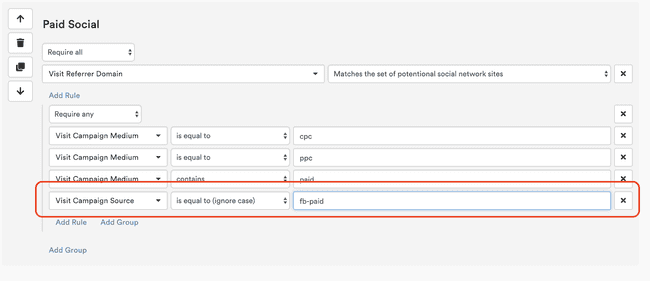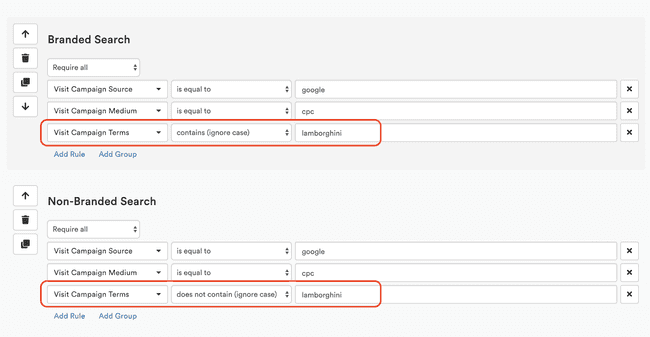Classifying marketing channels for higher resolution visibility and accuracy
Most marketers start much of their analysis and decision process by looking at how certain channels are performing. By channels I mean Organic, Social, Paid Search and so forth. Often the definition of these channels is based on how Google Analytics or other analytics platforms automatically bucket traffic into these channels by looking at referral information and UTM parameters that come along with each visit to a site.
Garbage In. Garbage Out.
There are however problems with this way of bucketing your traffic into channels. The most common being susceptibility to “garbage in, garbage out”. In both large and small organizations, often there are multiple people that may create and manage digital campaigns. Sometimes it’s a result of working with multiple external marketing partners that follow their own campaign naming conventions. In other cases it’s simply a result of unenforced internal policies on how to use campaign parameters consistently. And yet there are other cases where it’s simply a result of the traffic not coming with enough data, or simply something as benign as capitalizing characters, for example ‘E’ vs an ‘e’.
The scariest part of this is that if you’re focused on just the channel level, you might not see how this manifests in your data. When we first introduced our detailed campaign report in Trialfire, which lets you drill into campaigns from channels down to source, mediums and so on, we started to see several real-world examples where traffic that should be classified in one channel was classified in another. For example we saw Paid Search visits being bucketed into Paid Social. This has huge impacts on your potential to accurately measure ROI.
A quick search on the interweb and you can find many people asking about why their traffic isn’t being classified properly. In one example, a digital marketer, Liley, asks “I’m running email campaigns and all of the traffic that comes from those campaigns is being put into the Referral channel.”
In Liley’s case the result is probably the fact that the click-through links in the campaigns are simply not tagged or missing tags. Maybe it’s an oversight by Liley when setting up the campaigns, or maybe it’s a limitation of the email marketing platform.
Another possible reason is simple an issue of case sensitivity. In Google Analytics for example, the default rules that classify traffic based on UTM parameters are case sensitive. So even if Liley ensured the email links were properly tagged, but specified ‘Email’ as opposed to ‘email’ in the utm_medium, Google wouldn’t understand that it should be classified into the email channel.
Long story short, regardless of the cause of the misclassification, we’re still stuck with garbage in our data, that impacts our analysis.
Channel Classification is an opportunity to learn more.
But there’s more than just the issue of mis-classification that affects a marketer’s ability to better understand and affect channel performance. Sure misclassifying Facebook traffic as “Search channel” is a problem, but the benefits of correct classification goes much deeper than simply cleaning garbage data. This is extremely relevant in a multi-channel marketing environment, and even more so when leveraging data-driven attribution models like Trialfire’s which is based on collaborative game theory.
We introduced the Channel Classifier functionality in Trialfire to allow our customers to move traffic classified in any channel to another. We do this by allowing you to create rules that look at various aspects of the traffic coming to your site and classify that traffic as the correct channel, as well as to apply the classification retroactively to all historic data, correcting any previous misclassifications.
Use Case 1 : Taking out the garbage
A common problem faced by our clients (and most marketers) is traffic getting bucketed into the wrong channels, some examples as to the causes have been illustrated above. The truth is, this is an ongoing problem, and even marketing environments with the most rigid campaign tagging policies in place are susceptible to it.
So, to fight the good fight, we’ve set up Trialfire Channel Classifier to be easy to use and apply to both new and historic traffic. One of the many examples we’ve run into was the result of a client’s agency partner using a specific tagging convention for Paid Social campaigns:
yoururl.com/?utm_source=fb-paid&utm_medium=cpc&utm_c...This traffic was being classified as Paid Search as a result of cpc being in the utm_medium. With Trialfire, a simple change to the rule that classifies traffic as Paid Social was made to ensure the proper classification. Basically, if fb-paid was found in the source, bucket the traffic into the Paid Social channel. Done!
 The result is that the traffic tagged with fb-paid, was bucketed in the appropriate channel along with other traffic that originated from Social sites and had a cpc in the utm_medium.
The result is that the traffic tagged with fb-paid, was bucketed in the appropriate channel along with other traffic that originated from Social sites and had a cpc in the utm_medium.
Use Case 2 : Classifying non-tagged traffic
Recently, a Trialfire customer wanted to better understand how a very specific referral from a local online newspaper article was contributing to their overall marketing efforts. Specifically, how this touchpoint factored into the data-driven attribution model in Trialfire. Since the referring link had no UTM parameters - it wasn’t in the client’s control - traffic originating from this source was being classified generically in the Referral channel.
They decided to break out these specific referrals into a unique channel named Referral Local. This new channel could then be analyzed quickly in a number of funnels and reports within Trialfire, but more importantly, became a specific touch-point, or “player” that participated in the attribution model.
To classify this traffic, they created a custom channel based on the referring information of the traffic. This is illustrated in the example below:
 To make the rule even more specific, they knew that the traffic they were interested in was being directed to a specific landing page so they added another rule based on that as well.
To make the rule even more specific, they knew that the traffic they were interested in was being directed to a specific landing page so they added another rule based on that as well.
 The result of splitting this traffic into its own channel provides the client higher resolution visibility. They were able to better understand the direct impact of that source of traffic, but more importantly how it influences other channels when part of an overall customer journey.
The result of splitting this traffic into its own channel provides the client higher resolution visibility. They were able to better understand the direct impact of that source of traffic, but more importantly how it influences other channels when part of an overall customer journey.
Use Case 3: All traffic within a channel is not created equally
The other day I was online looking to buy a car. Specifically, I was in the market for an ultra-fast Lamborghini super-car. (Okay not really, but let’s pretend). So I typed ‘lamborghini” into the Google. At the top of the results page was an advertisement for Lamborghini. I clicked the link to visit their site and learn more, and the dashboards at Lamborghini’s marketing department showed another Paid Search visit.
At about the same time my friend Tony recently came into a huge pile of money and was thinking he should spend it on a super-car. Something ultra-fast. So he jumped onto the Google and entered ultra-fast supercar. He also got an ad for Lamborghini, clicked it, racking up another Paid Search visit on the dashboards back at Lambo’s head office.
So we both ended up on the Lamborghini website through a Paid Search, but the question Lamborghini needs to ask itself is whether that traffic is the same. In one case, I was fully aware of their brand and my ad was served because I entered a ‘branded’ keyword. In Tony’s case, he was just looking for something that was ultra fast.
One of the important questions marketers should ask and understand is how ‘branded’ vs ‘non-branded keywords perform. They talk to different audiences, competition and costs for those keywords are usually different, and the purposes of branded keywords are often not about traffic but brand protection.
So from an analysis perspective, it’s easy to argue that mine and Tony’s traffic should be looked at differently. This is especially relevant in the context of attribution modeling within a platform like Trialfire, which looks at how different marketing touch-points work together to drive a conversion.
This approach applies to other channels as well. For example not all traffic that comes from email should necessarily be thought of as equal. The purpose of a newsletter or content email, is quite different than a transactional email such as an abandon cart email.
Based on this idea, that not all traffic in a channel is equal, a number of Trialfire clients have used the Channel Classifier to better understand the impact of specific types of touch-points along the customer journey within traditional lower resolution marketing channels. Let’s look at how this can be done quickly in Trialfire.
Let’s say that the links in ads for Lamborghini looked like the following:
The ad I clicked on:
http://www.lamborghini.com
?utm_source=google
&utm_medium=cpc
&utm_campaign=lambosupercar
&utm_terms=lamborghiniThe ad Tony clicked on:
http://www.lamborghini.com
?utm_source=google
&utm_medium=cpc
&utm_campaign=lambosupercar
&utm_terms=+supercar+ultrafastBy default both of these campaigns would be grouped into the paid search channel, however we can split the traffic for more granular analysis that relates to the effort, costs and audience associated with the traffic. This can be done by making two new Channel Classifiers. For this example, we could simply place a rule on whether the brand name was contained in utm_terms.

A bit of effort. A lot of value.
Marketing in a multi-channel marketing environment is complicated. Regardless of your attribution model, it’s imperative that your data is clean and you truly understand how your audience is getting to you. That said, with just a little effort you can get even more insight into how your marketing is performing to drive higher ROAS and a better understanding of your audience.
